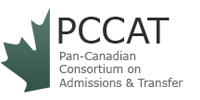 A group dedicated to easing student transfers between institutions will meet in Winsdsor in 2015.
A group dedicated to easing student transfers between institutions will meet in Winsdsor in 2015.
The Pan-Canadian Consortium on Admission and Transfer (PCCAT) conference will convene in Windsor in June 2015, says University of Windsor student recruitment officer Tim Brunet. The not-for-profit organization facilitates, researches and creates awareness about student transfer between post-secondary institutions.
“The group brings heft to the topic of student mobility through a robust membership that includes stakeholders from higher education institutions, provincial government organizations and other not-for-profit organizations interested in facilitating student mobility,” says Brunet, its vice-chair and the key player in bringing the conference to Windsor.
 The University of Windsor sponsored the consortium’s 2014 conference, June 18 and 19 in Quebec City. Highlights included the release of a co-sponsored research project titled ARUCC/PCCAT National Project Transcript Guidelines and Transfer Credit Nomenclature; the launching of a newly branded website pccatweb.org; a national jurisdictional update on transfer and mobility in Canada; and a meeting regarding Canada’s interest in the Groningen Declaration, an international agreement to create “common ground in best serving the academic and professional mobility needs of citizens worldwide by bringing together key stakeholders in the Digital Student Data Ecosystem.”
The University of Windsor sponsored the consortium’s 2014 conference, June 18 and 19 in Quebec City. Highlights included the release of a co-sponsored research project titled ARUCC/PCCAT National Project Transcript Guidelines and Transfer Credit Nomenclature; the launching of a newly branded website pccatweb.org; a national jurisdictional update on transfer and mobility in Canada; and a meeting regarding Canada’s interest in the Groningen Declaration, an international agreement to create “common ground in best serving the academic and professional mobility needs of citizens worldwide by bringing together key stakeholders in the Digital Student Data Ecosystem.”
Brunet says the number of students who are moving their credits and credentials to different jurisdictions within Canada is increasing: “There is much research to suggest that credit transfer and collaborative agreements are on the rise.”
He has encountered innumerable narratives as to why students transfer, including: moving for employment, upgrading credentials, searching for electives or online options, and switching academic pathways.
“The topic becomes increasingly complex for Canadian higher education institutions as students look to be acknowledged for transfers that are intra- and inter-provincial, college to university, university to college, college to college, and university to university,” says Brunet. “Beyond the geographical borders of Canada there are a number of other considerations, including international transfer agreements/organizations and an expanding number of organizations offering easily accessible Massive Online Open Courses (MOOCs). There is a lot of room for further research and discussion on the topic and how it will affect the future of higher education in Canada.”
Bringing the conference to Windsor in 2015 will provide local academics the opportunity to learn from transfer credit experts from throughout Canada and beyond, he says.
